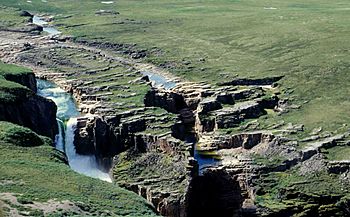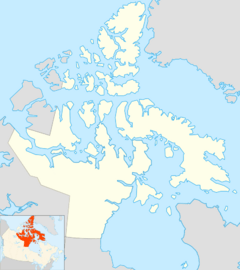Hood River (Nunavut) facts for kids
Quick facts for kids Hood River |
|
|---|---|

Kattimannap Qurlua formerly Wilberforce Falls
|
|
|
Mouth of the Hood River
|
|
| Country | Canada |
| Territory | Nunavut |
| Physical characteristics | |
| Main source | Napaktulik Lake 66°20′N 113°00′W / 66.333°N 113.000°W |
| River mouth | Bathurst Inlet 67°26′N 108°53′W / 67.433°N 108.883°W |
| Length | 400 km (250 mi) |
The Hood River is a cool river in Nunavut, Canada. It is about 400 km (250 mi) long. This river flows into the Arctic Ocean. It starts in the middle of Canada's tundra at Napaktulik Lake. This lake is very close to the Northwest Territories border. The Hood River ends at Arctic Sound, near the town of Bathurst Inlet. The river is located far north, above the Arctic Circle and the tree line. This means there are no trees growing along its banks.
Contents
Animals of the Hood River
The Hood River area is home to many amazing animals. You can find lots of lake trout in the river. Some of these fish can grow to be almost a metre long! That's like a giant fish.
Land Animals
Even though it's very cold, many large animals live here. On the river banks, you might see grizzlies, wolves, wolverines, and muskox. These animals are very common in this area.
Caribou Migration
In the short Arctic summer, canoeists can see something special. They might watch the huge migration of barren-ground caribou. These caribou travel through the area looking for food. It's an incredible sight to see so many animals moving together.
Amazing River Features
The Hood River is full of exciting natural features. You can find many rapids, waterfalls, and even glaciers along its path.
Wilberforce Gorge
One of the most impressive spots is Wilberforce Gorge. This is a very steep and deep gorge. It stretches for about 3 km (1.9 mi). The gorge is almost 76 m (249 ft) deep. Imagine a huge crack in the ground!
Kattimannap Qurlua Waterfall
At the start of Wilberforce Gorge is a famous waterfall. It is called Kattimannap Qurlua. This waterfall is the highest one north of the Arctic Circle. It drops 49 m (161 ft) in total. The water falls in two big steps, each about 24 m (79 ft) high. It's a truly powerful sight.
History and Exploration
The Hood River has an interesting history with early explorers.
Sir John Franklin's Expedition
Sir John Franklin was a famous explorer. He led an overland expedition called the Coppermine expedition. During this trip, he explored the Hood River. He came back up this river after traveling down the Coppermine River. Then he went east along the Arctic Coast to Point Turnagain. Franklin was searching for the Northwest Passage. This was a sea route connecting the Atlantic and Pacific oceans through the Arctic.
How the River Got Its Name
The Hood River is named after Midshipman Robert Hood. He was part of Sir John Franklin's team. Sadly, Robert Hood may have been murdered during the long trek back to Fort Enterprise. The river keeps his name to remember him.


